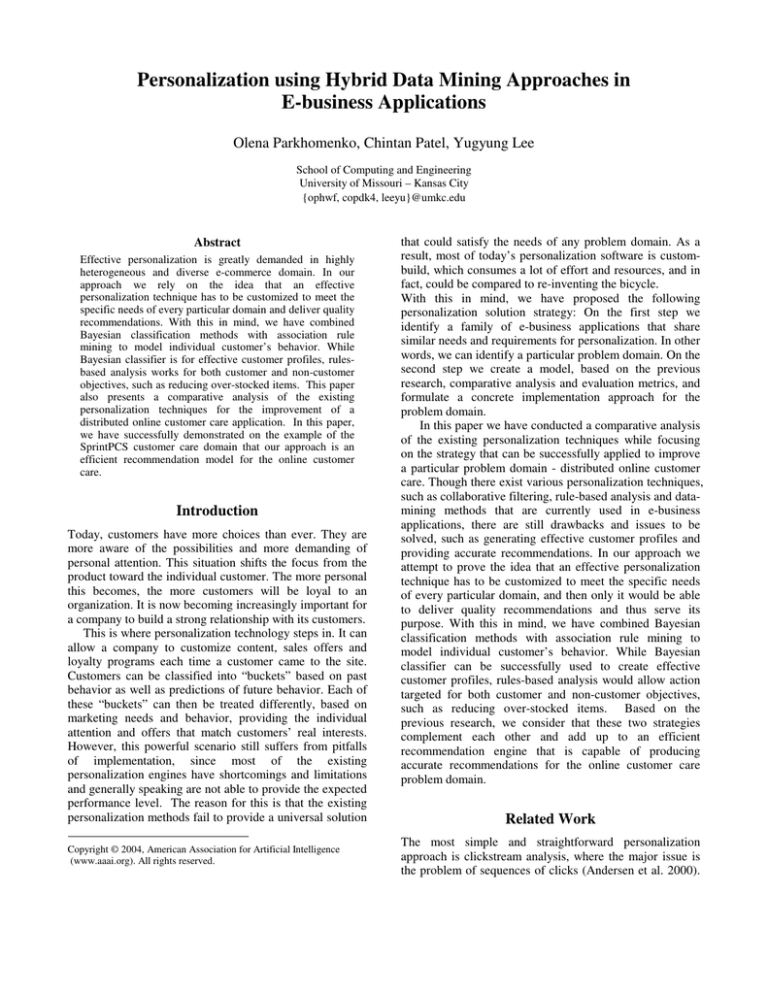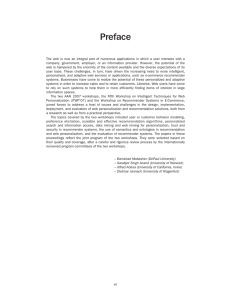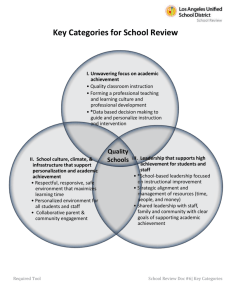
Personalization using Hybrid Data Mining Approaches in
E-business Applications
Olena Parkhomenko, Chintan Patel, Yugyung Lee
School of Computing and Engineering
University of Missouri – Kansas City
{ophwf, copdk4, leeyu}@umkc.edu
Abstract
Effective personalization is greatly demanded in highly
heterogeneous and diverse e-commerce domain. In our
approach we rely on the idea that an effective
personalization technique has to be customized to meet the
specific needs of every particular domain and deliver quality
recommendations. With this in mind, we have combined
Bayesian classification methods with association rule
mining to model individual customer’s behavior. While
Bayesian classifier is for effective customer profiles, rulesbased analysis works for both customer and non-customer
objectives, such as reducing over-stocked items. This paper
also presents a comparative analysis of the existing
personalization techniques for the improvement of a
distributed online customer care application. In this paper,
we have successfully demonstrated on the example of the
SprintPCS customer care domain that our approach is an
efficient recommendation model for the online customer
care.
Introduction
Today, customers have more choices than ever. They are
more aware of the possibilities and more demanding of
personal attention. This situation shifts the focus from the
product toward the individual customer. The more personal
this becomes, the more customers will be loyal to an
organization. It is now becoming increasingly important for
a company to build a strong relationship with its customers.
This is where personalization technology steps in. It can
allow a company to customize content, sales offers and
loyalty programs each time a customer came to the site.
Customers can be classified into “buckets” based on past
behavior as well as predictions of future behavior. Each of
these “buckets” can then be treated differently, based on
marketing needs and behavior, providing the individual
attention and offers that match customers’ real interests.
However, this powerful scenario still suffers from pitfalls
of implementation, since most of the existing
personalization engines have shortcomings and limitations
and generally speaking are not able to provide the expected
performance level. The reason for this is that the existing
personalization methods fail to provide a universal solution
Copyright © 2004, American Association for Artificial Intelligence
(www.aaai.org). All rights reserved.
that could satisfy the needs of any problem domain. As a
result, most of today’s personalization software is custombuild, which consumes a lot of effort and resources, and in
fact, could be compared to re-inventing the bicycle.
With this in mind, we have proposed the following
personalization solution strategy: On the first step we
identify a family of e-business applications that share
similar needs and requirements for personalization. In other
words, we can identify a particular problem domain. On the
second step we create a model, based on the previous
research, comparative analysis and evaluation metrics, and
formulate a concrete implementation approach for the
problem domain.
In this paper we have conducted a comparative analysis
of the existing personalization techniques while focusing
on the strategy that can be successfully applied to improve
a particular problem domain - distributed online customer
care. Though there exist various personalization techniques,
such as collaborative filtering, rule-based analysis and datamining methods that are currently used in e-business
applications, there are still drawbacks and issues to be
solved, such as generating effective customer profiles and
providing accurate recommendations. In our approach we
attempt to prove the idea that an effective personalization
technique has to be customized to meet the specific needs
of every particular domain, and then only it would be able
to deliver quality recommendations and thus serve its
purpose. With this in mind, we have combined Bayesian
classification methods with association rule mining to
model individual customer’s behavior. While Bayesian
classifier can be successfully used to create effective
customer profiles, rules-based analysis would allow action
targeted for both customer and non-customer objectives,
such as reducing over-stocked items. Based on the
previous research, we consider that these two strategies
complement each other and add up to an efficient
recommendation engine that is capable of producing
accurate recommendations for the online customer care
problem domain.
Related Work
The most simple and straightforward personalization
approach is clickstream analysis, where the major issue is
the problem of sequences of clicks (Andersen et al. 2000).
Next comes probably the most popular personalization
technology of today’s market - collaborative filtering. Pure
collaborative filtering suffers from a variety of limitations,
such as scalability and effectiveness in the face of very
large and sparse data sets. Offline clustering of user
transactions can significantly improve the efficiency of
such systems, however, at the cost of decreased accuracy.
In the case of anonymous web usage data there is also the
challenge of accurately predicting user interests based on
very short user clickstream trails, and without the benefit of
more detailed user information (Mobasher et al. 2001).
Clustering and data-partitioning algorithms in collaborative
filtering can potentially improve the quality of
collaborative filtering predictions and increase the
scalability of collaborative filtering systems (O’Connor and
Herlocker 1999).
GroupLens (Sarwar et al. 1998) implemented a hybrid
collaborative filtering that supports content-based filters
and users. The proposed filterbots help with the problem of
sparsity, however since the GroupLens predictions still use
a collaborative filtering approach, new users, and hence,
new filterbots, still suffer from the early rater problem.
Claypool et al. (1999) proposed a similar approach that
combined collaborative filtering with content-based
filtering techniques and had shown to successfully mitigate
most shortcomings, but scalability. Breese et al. (1998)
identified two major classes of prediction algorithms memory-based and model-based. Memory-based methods
are simpler, but computationally expensive and cannot
provide explanations of predictions or further insight into
the data. For model-based algorithms, the model offers an
intuitive rationale for recommendations making
assumptions more explicit.
A method, called personality diagnosis was proposed by
Pennock and Horvitz (2000). For large amounts of data, a
straightforward application of personality diagnosis
however, suffers from the same time and space complexity
concerns as memory –based methods. Larsen (1999)
presents a new personalization-centric concept – the idea of
linking all customer touch points to a single database that
proved to be a highly successful business practice.
An alternative classification of recommendation
methods was proposed by Karypis (2001), where he
presents a class of item-based recommendation techniques
as opposed to the user-based collaborative filtering to
address the scalability issues. Some recent studies have
considered the use of association rule mining in
recommender systems. However, there has been a little
focus on the impact of factors such as the support threshold
or the size of user history on the effectiveness of
recommendations (Mobasher et al. 2001). Another data
mining approach, the “mixed-effects” model for
recommender systems was applied, using a Bayesian
methodology with intention to address the cold-start issue,
scalability and sparse ratings problem (Condliff et al.
1999).
O’Connor (2001) pointed out the area where rulesbased personalization outperforms other techniques – with
complex transactions, in which the seller has clear,
structured, and well-defined practices in identifying which
customers it wants to do business with and how it needs to
conduct these relationships. Aggarwal (1996) studied the
problem of on-line mining of customer profiles specified
with association rules. Adomavicius and Tuzhilin (2001)
also presented a framework for building behavioral profiles
of individual users. One point becomes persistently clear
from all the above discussion – the effective
personalization has to be domain specific. Therefore, a
profound domain analysis is very important. Our research
paper focuses on personalization solutions for online
customer care, thus we have investigated the specific
aspects of this domain.
Personalization Approach
In this section we propose a personalization approach for
an online customer care application and present the
selected combination of personalization methods.
An online customer care application of a large
telecommunications company that can be used in various
points of contact with the customer (such as Call Centers,
Internet web site, specialized retail stores) should be able to
successfully apply personalization technique to two types
of customers: existing and new. An existing customer is
the one who has already purchased a plan, and hence has
his data and at least a partial profile in the system. A new
customer is the one who still has to choose a subscription
plan and a phone, and for whom no profile is stored in the
system. In our opinion, these two customer types require a
different personalization treatment that would allow
maximizing the quality of recommendations.
Our personalization approach is to create explicit
customer profiles using hybrid data mining approaches
based on domain models and customer data implicitly
generated from current or previous customer’s information
and behavior. Our approach is to incorporate rule-based
analysis following the solid customer profile model
developed by Adomavicius and Tuzhilin (2001). A
complete customer profile model consists of two parts:
factual and behavioral. The factual profile contains
information, such as income, age, job that the
personalization system obtained from the customer’s
factual data. The factual profile also can contain
information derived from the transactional data, such as
“the customer tends to purchase only universal phone
accessories” or “the customer biggest purchase was $300”.
A behavioral profile is usually derived from transactional
data and models the customer’s actions, for example,
“when Josh buys a universal accessory, he also buys a
complimentary phone-specific accessory”. Collaborative
filtering is the dominant technology for developing insight
and providing recommendations. However, having
analyzed the personalization issues relevant for our domain,
New
User
Question/Answer 1
Question/Answer 2
Question/Answer 3
….
Question/Answer n
Existing
User
Transaction 1
Transaction 2
Transaction 3
…
Transaction n
Initial Profile Building
using Bayesian
classifier
Customer
Care
Profile Refinement using
Association Rule
Generation
Refined
Profile
Initial
Profile
Support/Recom 1
Support/Recom 2
Support/Recom 3
…
Support/Recom n
Customer Care based pm
Personalization supported
by Profiles
Shareable
Profile
Profile Repository
Figure 1. Architecture of Hybrid Personalization System
we have come to the conclusion that it would be ineffective
for our domain. Therefore we will use Bayesian
classification methods complemented by rules-based
analysis that would allow action based on both customer
and non-customer objectives, such as reducing overstocked items or recommending geographic-specific
subscription plan. Our recommendation model includes
three components (Figure 1):
Initial profile: For a new customer that does not yet have
any profile created for him, a personalization engine should
be able to recommend a phone model and a subscription
plan. For this purpose we will use naïve Bayesian classifier
that can, based on, for example, customer’s lifestyle, and
wireless needs, match his class label, from where
recommendations can be driven.
Refined profile: For an existing customer, to maintain
and update the profile, we can use the data generated by
Bayesian classifier and apply association rules, discovered
for the class where customer belongs to. Thus we can
create an accurate customer profile and, based on the
profile, recommend phone-specific accessories and
universal accessories. For customer retention, a successful
personalization engine can also suggest an adjusted
subscription plan that would better meet customer’s needs.
Sharable profile: Once the customer profile has been
refined with the other customer transaction-based
association rules, and updated with the customer’s own
transaction rules, both factual and behavioral part of the
customer profile are complete and it becomes a sharable
profile. Now we can use this customer’s profile for both
generating effective recommendations this and other
existing customers and refining profiles of new customers.
The following step-by-step profile enhancement and
updating generates the personalization model:
1. Use Bayesian classifier to identify or predict a class
label for a new customer (use to identify both Phone Type
class label Gk and Plan Type class label Ci ). On the first
step we have determined which class a new customer
belongs to. In our system, a data repository Di, i=1,.., m is
associated with each class Ci, and contains a list of
transactions, completed by the members of the class Ci.
Now we describe the proposed personalization model in
more detail. The naïve Bayesian classifier makes
assumption of class conditional independence, that is, given
the class label of a sample, the values of the attributes are
conditionally independent of one another. For our domain
the assumption holds true, and therefore the naïve Bayesian
classifier is the most accurate in comparison with all other
classifiers (Han and Kamber 2001). Once the new customer
has purchased a plan and a phone, it is time to create
his/her profile, which subsequently can be used to provide
better recommendations to that customer, as well as to
derive improved marketing solutions.
2. In the second step, we use association rules to model
individual customer’s behavior. Rule discovery methods
are applied individually to every customer’s data. To
discover association rules that describe the behavior of
individual customers, we use Apriori algorithm. Once the
class labels are determined by the Bayesian classifier in the
first step, we apply association rules generated for the
existing customers of the selected Plan Type and Phone
Type classes to recommend accessories/special promotions
to the new customer. Since the rules are mined only for 2
respective transaction data repositories, this kind of
clustering enforces a better scalability and thus improved
real-time performance of the system. Because data mining
methods discover rules for each customer individually, the
selected methods work well for applications containing
many transactions for each customer, such as credit card,
online browsing, etc. In our application domain, it is also
possible to obtain a payment transaction pattern and thus
address fraud issues.
3. The discovered strong association rules can be used
to further recommend accessories and plan adjustments to
that customer. This step completes both factual and
behavioral parts of customer profile and is now becomes a
sharable profile that can be used by the system to mine
rules for and update other customers’ profiles. This step
completes the behavioral part of the customer profile which
can now be shared by other customers.
Case Study: SprintPCS Customer Care
To demonstrate our implementation model and approach,
we will use the data that belongs to a large
telecommunications company, namely SprintPCS.
According to the company’s annual report, the estimated
number of customers as of the year 2002 is 26 million
nation-wide. SprintPCS products include various phone
models (around 300), phone-specific accessories (around
6000), a number of universal accessories (around 200) 1 ,
and finally a selection of customized phone plans, targeted
for various age and social groups. Our data model is an
approximation of a real-life data model, and is based on
information collected about SprintPCS customer care
domain. It includes five classes Customer, Phones,
Accessories, PlanType and PlanItemized.
Customer
a. lifestyle: {family, business_associates, friends, combo}
b. wireless
needs:
{socially_connected,
secure,
max_efficiency}
c. region: {determined by a zip code}
d. technology: {standard, latest}
Phones{Samsung, Nokia, …}
Accessories {standard_battery, vehicle_power_adapter,
leather_case, hands_free_car_kit, desktop_charger,
travel_charger, wireless_web_connection_kit}
PlanType {standard, total_digital_connections, family}
PlanItemized {callerId, long_distance, call_waiting,
operator_services, 3way_calling, call_forwarding, voicemail,
directory_assistance}
The Customer class has four attributes, each of which has
several possible parameters that are meant to identify a
customer’s potential preferences for a phone model and
plan type. The Phones class contains a list of available
phone models, while the Accessories class contains the
available phone accessory types. The PlanType class shows
1
These numbers are a result of our own observations.
three major categories of phone plans, and PlanItemized
has a list of services and features that might or might not
have a particular phone plan. In this data model customer’s
lifestyle, wireless needs and region will influence a service
plan type class selection, a phone class will be selected
based on wireless needs and technology.
Let us assume there is a new customer who intends to
sign up for a PCS service that is to purchase a phone and a
respective phone plan.
In the first step, we have to determine customer’s location
to validate that the company provides coverage for that
area. Next step would be to define customers’ needs, or in
other words, what type of customer he/she is – a business
man, or family member, or a teenager who has a lot of
friends to chat with, or a combination of these.
Customer lifestyle: “family”
Customer wireless needs: “max_efficiency”
Customer region: “44056”
Customer technology:”standard”
_______________________________
Customer phone range:”Samsung SPH-I300, Sanyo SCP6000”, Sanyo SCP-5750”
Figure 2. Initial customer profile
Customer lifestyle: “family”
Customer wireless needs: “max_efficiency”
Customer region: “44056”
Customer technology:”standard”
_______________________________
Customer selected phone:”Samsung SPH-I300”
_______________________________
Customer plan type:”total_digital_connections8000minutes”
Figure 3. Refined customer profile
And final step would be to find out in what kind of
technology the new customer is interested, which also
determines the price of the phone model to be suggested.
Customer Profiling
Once all the essential primary data is collected we can
apply the initial Bayesian classification to determine the
new customer’s class labels for a plan type and phone
model. Once the plan type is determined, we can further
apply Bayesian classifier to determine phone model type to
be recommended to the customer. Also to ensure
satisfaction and precision of the choice, at least three most
probable phone models are displayed. This way, the
recommendation engine can also learn more about this
customer from the choice preference that he makes.
At this stage our system would have created the initial
customer profile (Figure 2), based on the customer factual
data only.
Customer name: “John Doe”
Customer lifestyle: “family”
Customer wireless needs: “max_efficiency”
Customer region: “44056”
Customer technology:”standard”
_______________________________
Customer selected phone:”Samsung SPH-I300”
_______________________________
Customer plan type:”total_digital_connections-8000minutes”
_______________________________
Rules:
{if purchases long _distance, is likely to purchase
operator_services}
{if purchases vehicle_power_adaptor, is likely to purchase
hands_free_car_kit}
Figure 4. Sharable customer profile
Note that this profile still has a range of possible phones
and plans that are likely to be selected by the customer. At
this point we collect customer’s input about his selection
and update the profile correspondingly.
Once we have classified the customer’s into specific
classes based on his selection (which in case of a returning
customer can be a completed transaction), we can apply
Apriori algorithm to mine for the association rules
discovered for the members of those classes and update
customer’s profile with those rules, thus creating a refined
customer profile that can look like Figure 4.
Once customer has completed one or more transactions that
would include accessories and services, we can use Apriori
algorithm and validate the previously discovered rules for
that customer as well as update customer’s behavioral
profile with the rules discovered from his own transactions.
The discovered strong association rules can be used to
further recommend accessories and plan adjustments to that
customer. This step completes both factual and behavioral
parts of customer profile and is now becomes a sharable
profile that can be used by the system to mine rules for and
update other customers’ profiles. After these steps are
completed, the recommendation engine will display
suggestions to the customer. This step-by-step profile
enhancement and updating will guarantee that all customer
profiles are accurate and up to date.
Previous research shows that for a given set of taskrelevant data, the data-mining process may uncover
thousands of rules, many of which are uninteresting for the
marketing expert. Therefore, the next step would be to
apply constraint-based mining, where mining is performed
under the guidance of various kinds of provided constraints.
These constraints can include knowledge type constraint,
data constraint, dimension constraint, interestingness and
rule constraints.
Comparative Analysis
Based on the previously conducted research and
experimental results we have drawn a chart (Table 1) that
provides a complete picture of various personalization
approaches vs. limitations and shortcomings.
Scalability: While most of the today’s algorithms are able
to process tens of thousands of customers and product
items in real time, but the demands of modern e-commerce
systems are to process tens of millions of items and
customers.
Quality of recommendations: This is measured in terms
of both coverage and accuracy (precision) of the produced
recommendations.
Sparsity: If the number of items far exceeds what any
individual can hope to absorb, the matrices containing the
ratings of all items are very sparse.
Real-time performance: This factor is closely related to
the problem of scalability.
The early rater issue: This has to do with providing a
prediction for an item when it first appears, since there are
no user ratings on which to base the predictions. Similarly,
even an established system will provide poor predictions
for each and every new user that enters the system.
Synonymy: This can worsen the quality of
recommendations in those information domains where very
similar items have different names, and the similarity
cannot be recognized by the system, while evaluating
customer ratings on the similar items.
The first conclusion that can be drawn from the chart is
that a hybrid approach that combines several methods is
more efficient than a straightforward approach. Secondly,
each approach usually has its best performance area. All
the issues listed in the chart might not be relevant for a
particular problem domain. For example, for online
customer care domain only scalability, quality of
predictions, and real-time performance are the important
requirements, which we have addressed and fulfilled.
Conclusions
In this paper we have conducted a profound comparative
analysis of the existing personalization techniques and
evaluated that a hybrid personalization approach that
combines several methods is more efficient than a single
approach. Since an effective personalization technique has
to be customized to meet the specific needs of every
particular domain and deliver quality recommendations and
thus serve its purpose. Our approach based on the
combination of Bayesian classification methods with
association rule mining is used to model individual
customer’s behavior. While Bayesian classifier can be
successfully used to create effective customer profiles,
rules-based analysis would allow action targeted for both
customer and non-customer objectives, such as reducing
over-stocked items. In this paper, we demonstrate through
a case study that our recommendation system is capable of
producing accurate recommendations for the online
customer care problem domain.
Scalability Quality of
predictions
+/-
Sparsity Early rater Synonymy Privacy
Real-time
issue
performance
N/A
-
Pure Collaborative Filtering (Mobasher et al.
2001)
Pure Clickstream Analysis (Andersen et al.
+/N/A
+
N/A
2000)
Clustering and collaborative filtering (O’Connor
+
+/N/A
N/A
and Herlocker 1999)
Clickstream analysis using subsessions (Breese
-/+
N/A
N/A
+
N/A
N/A
et al. 1998)
Content-based filtering agents in collaborative
filtering (hybrid approach)
+/+
+
N/A
N/A
(Claypool et al. 1999)
Content-based and collaborative filters (non+
+
+
N/A
hybrid approach) 6. (Sarwar et al. 1998)
Item-based Top-N Recommendation algorithms
+
+
N/A
N/A
N/A
(Karypis 2001)
Bayesian Mixed-Effects Model (Condliff et al.
+
+/+
+
N/A
N/A
1999)
Rules-based personalization (O’Connor 2001)
+
+/N/A
Pure Data-mining methods (Mobasher et al. /
+/+/+/Adomavicius and Tuzhilin 2001),
+
+
N/A
N/A
N/A
N/A
Our personalization model
(“N/A”: Not Addressed, “+” : issue is resolved, “-” : issue is not resolved , “+/-”: issue is partially resolved)
+/+/+
+/+/+
+
+/+
Table 1. Comparative analysis of personalization approaches
References
Agrawal, R. Mannila, H. Srikant, R. Toivonen, H.
Verkamo. 1996. Fast discovery of association rules. In
Advances in Knowledge Discovery and Data Mining, U.
Fayyad, G. Piatetsky-Shapiro, P. Smyth, R. Uthurusamy
(Eds.). AAAI Press, Melo Park, CA.
Andersen, J., Larsen, R. S., Giversen, A., Pedersen, T.B.,
Jensen, A.H., Skyt, J. 2000. Analyzing Clickstreams Using
Subsessions. In Proceedings of the 3rd International
Workshop on Data Warehousing and OLAP, pp. 25 – 32.
Adomavicius, G., Tuzhilin, A. 2001. Using Data Mining
Methods to Build Customer Profiles. IEEE Computer
34(2): 74-82
Adomavicius, G., Tuzhilin, A. 2001. Expert-Driven
Validation of Rule-Based User Models in Personalization
Applications. Data Mining and Knowledge Discovery
5(1/2): 33-58
O’Connor, A. 2001. Personalization Coming Full Circle,
Part 2.
Badrul M. Sarwar, Joseph A. Konstan, 1998. Al Borchers,
Jon Herlocker, Brad Miller, John Riedl, Using Filtering
Agents to Improve Prediction Quality in the GroupLens
Research Collaborative Filtering System. In Proceedings of
the ACM Conference on Computer Supported Cooperative
Work.
Breese, J.S., Heckerman, D., Kadie C. 1998. Empirical
Analysis of Predictive Algorithms for Collaborative
Filtering. In Fourteenth Conference on Uncertainty in
Artificial Intelligence, November.
Claypool, M., Gokhale, A., Miranda, T., Murnikov, P.,
Netes, D., Sartin, M. 1999. Combining Content-Based and
Collaborative Filters in an Online Newspaper. ACM SIGIR
Workshop on Recommender Systems, Berkeley.
Condliff, M.K., Lewis, D.D., Madigan, D., Posse C. 1999.
Bayesian Mixed-Effects Models for Recommender Systems.
In ACM SIGIR Workshop on Recommender Systems:
Algorithms and Evaluation.
Larsen, S. 1999. Developing the Personal-Centric
Enterprise through Collaborative Filtering and Rules-Based
Technologies. A CRM Project.
Mobasher, B., Dai, H., Luo, T., Nakagawa, M. 2001.
Improving the Effectiveness of Collaborative Filtering on
Anonymous Web Usage Data, In Proceedings of the IJCAI
2001 Workshop on Intelligent Techniques for Web
Personalization (ITWP01), Seattle.
Mobasher, B., Dai, H., Luo, T., Nakagawa, M. 2001.
Effective Personalization Based on Association Rule
Discovery from Web Usage Data, In Proc. of ACM
Workshop on Web Information and Data Management
(WIDM) pp. 103-112.
O’Connor, M., Herlocker, J., 1999. Clustering Items for
Collaborative
Filtering,
ACM
SIGIR
'99
Workshop on Recommender Systems: Algorithms and
Evaluation
George Karypis, 2001. Evaluation of Item-Based Top-N
Recommendation Algorithms. In Proceedings of CIKM.
Pennock, D.M., Horvitz, E. 2000. Collaborative Filtering
by Personality Diagnosis: A Hybrid Memory – and ModelBased Approach. In Uncertainty in Artificial Intelligence,
pages 473 – 480.
Han, J., Kamber, M. 2001. Data Mining: Concepts and
Techniques, pp. 298-300






